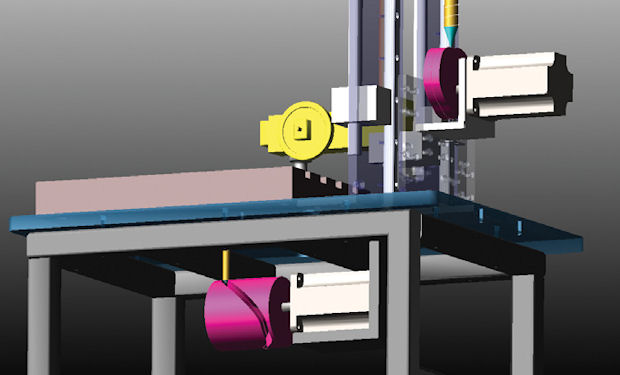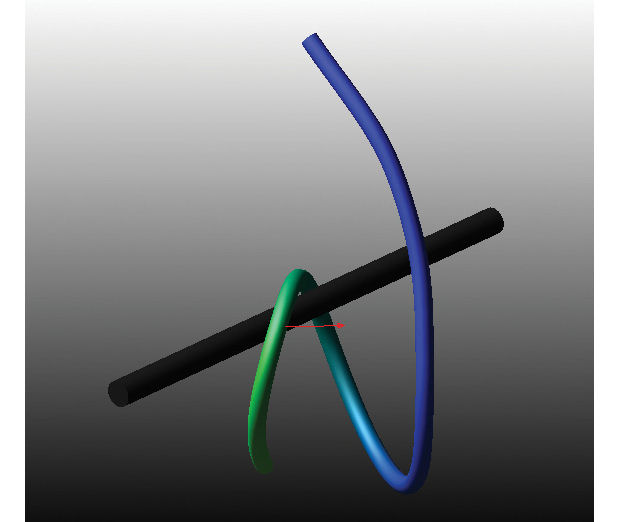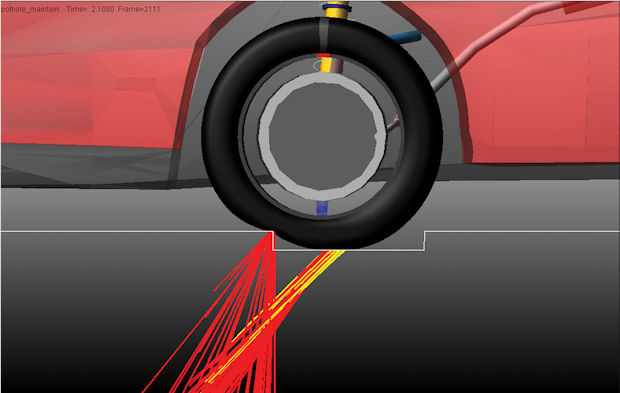Latest News
September 3, 2014
MSC Software has released the 2014 version of its Adams multibody dynamics simulation solution suite. Adams 2014 introduces new native nonlinear part modeling and analysis as well as a functionality for co-simulation between Adams and MSC’s Marc nonlinear finite element analysis (FEA) solution. These enhancements, says MSC, address the challenge of efficiently designing and testing mechanical systems that result from the lack of a smooth integration between system dynamics and FEA domains. Adams 2014 also extends the solution set’s machinery and automotive industry versions with a new Cam Module in Adams/Machinery and extended vehicle modeling and rollover events capabilities in Adams/Car.
 The new Adams/Machinery Cam module lets engineers model cam-follower systems within the Adams/View environment. Image courtesy of MSC Software.
The new Adams/Machinery Cam module lets engineers model cam-follower systems within the Adams/View environment. Image courtesy of MSC Software.Adams 2014 debuts FE Part, a new Adams-native modeling object for very large deformation use cases that specifically consider geometric nonlinearity. The formulation options, explains MSC, are based on its adaptations of the Absolute Nodal Coordinate Formulation (ANCF) and Geometrically Exact Beam Formulation (GEBF). With these capabilities, engineers can more accurately calculate dynamic loads for geometrically nonlinear parts within a multibody dynamic system, according to MSC.
FE Part offers a basic 2D option as well as a 3D Beam formulation option. The latter MSC portrays as a 3D, fully geometrically nonlinear representation useful for beam-like structures. A new FE Load feature provides the Adams/View pre-processor with support for the creation, visualization, and modification of FE Parts as well as the application of distributed loads. MSC reports that in some benchmark test cases, modeling time was reduced from 8 hours to 30 minutes.
 Adams 2014 introduces FE Part, a new Adams-native modeling object for nonlinear part modeling and analysis. Image courtesy of MSC Software.
Adams 2014 introduces FE Part, a new Adams-native modeling object for nonlinear part modeling and analysis. Image courtesy of MSC Software.The new Adams-Marc co-simulation capability enables users to perform co-simulation between Adams and Marc nonlinear FEA software. This functionality, explains MSC, lets engineers using Adams for multibody dynamics increase model accuracy by including geometrically and materially nonlinear structural behavior, while engineers performing FEA can study components with realistic boundary conditions. The co-simulation, says MSC, delivers “dramatic time savings” for users running nonlinear FE analyses because they can now simulate some rigid moving parts in Adams rather than in the FEA environment.
MSC says that the new Adams/Machinery Cam Module provides easy-to-use modeling of cam-follower systems that may comprise various combinations of cam shapes, follower motions, follower arrangements, and follower geometry. The Cam Module, the company adds, makes cam model creation much faster and makes design changes to mechanism motions and the cam profile easier to perform.
 New FTire capabilities in Adams 2014/Car enable animations of contact forces and tire deformation forces. Image courtesy of MSC Software.
New FTire capabilities in Adams 2014/Car enable animations of contact forces and tire deformation forces. Image courtesy of MSC Software.New vehicle modeling improvements in Adams/Car include stability events, FTire animations and SmartDriver enhancements. Adams/Car now provides three new rollover stability test events: Embankment, Corkscrew and Sand Bed. For tire force elements used in vehicle ride and stability studies, Adams/Car 2014’s FTire contact forces and tire deformation forces can now be animated within the Adams/PostProcessor. According to MSC, this capability should provide engineers with higher-fidelity analysis and visualization of vehicle ride events such as tires rolling over various surfaces.
MSC says that Adams/Car 2014’s SmartDriver enhancements address the continuing evolution of vehicle performance and handling tests and the need to model and simulate these events virtually. Enhancements to SmartDriver include improved backwards driving for open loop events with support for both simple and automatic powertrains, additional speed profile spline interpolation improvements, continuous target acceleration and smoother throttle and brake signals.
For more details about the Adams 2014 release, go to MSC Software.
Watch an on-demand webinar on the Adams 2014 new release.
Download the Adams 2014 brochure.
Download the Adams data sheet.
Watch the “Top Ten Reasons to Use MSC Adams” video.
See why DE‘s Editors selected Adams 2014 as their Pick of the Week.
Sources: Press materials received from the company and additional information gleaned from the company’s website.
Subscribe to our FREE magazine, FREE email newsletters or both!
Latest News
About the Author
Anthony J. Lockwood is Digital Engineering’s founding editor. He is now retired. Contact him via [email protected].
Follow DE





